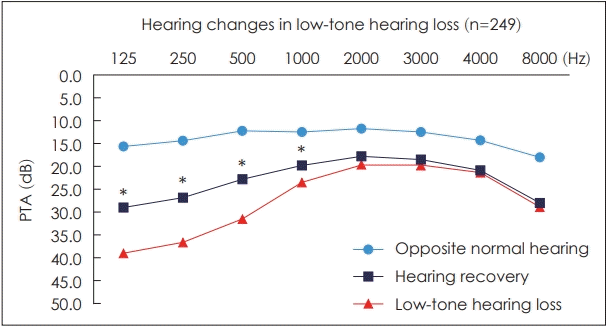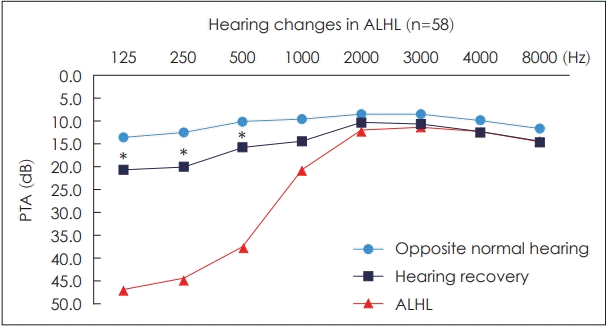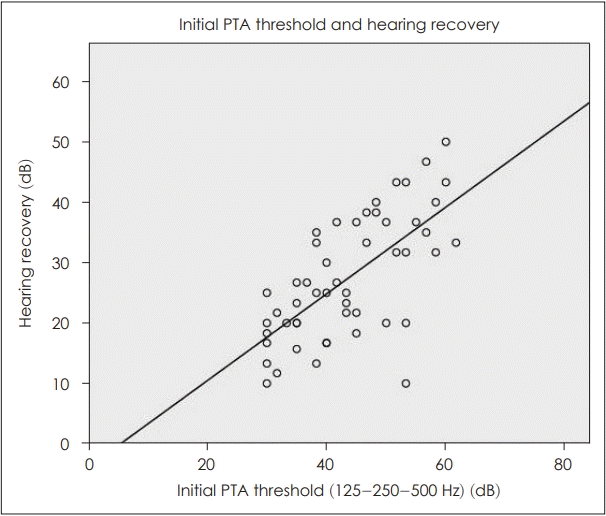Introduction
Subjects and Method
Study design
Statistical analysis
Results
Demographic data
Table 1.
In total, 249 patients exhibit low-tone hearing loss of more than 10 dB without vertigo in this study. Out of 249 patients, 58 patients exhibited ALHL. ECoG and VEMP IAD values are not signifcantly different between the two groups. ALHL: acute lowtone hearing loss, ECoG: electrocochleography, VEMP IAD: vestibular evoked myogenic potential inter-aural amplitude difference
Hearing changes in the low-tone hearing loss group (n=249)
 | Fig. 1.Low-tone hearing loss and recovery. Low-tone hearing loss group included a total of 249 patients with symptoms of low-tone hearing loss more than 10 dB and ear fullness without vertigo. Mean low-tone hearing loss was 35.6 dB (38.9 dB at 125 Hz, 36.5 dB at 250 Hz, and 31.3 dB at 500 Hz) in the PTA. This hearing loss recovers to 26.2 dB (29.1 dB at 125 Hz, 26.9 dB at 250 Hz, and 22.8 dB at 500 Hz) following combined treatment of diuretic and oral steroid therapy. Low-tone hearing loss recovers significantly after therapy, particularly at 125, 250, 500, and 1000 Hz (*p<0.001, paired t-test). Opposite normal hearing is represented in the PTA. PTA: pure tone audiometry. |
Hearing changes in the ALHL group (n=58)
 | Fig. 2.ALHL and recovery. ALHL group included fifty eight out of 249 patients with low-tone hearing loss more than 10 dB. Mean ALHL was 42.8 dB (46.6 dB at 125 Hz, 44.4 dB at 250 Hz, and 37.4 dB at 500 Hz) in the PTA. This hearing loss recovers to 18.9 dB (20.9 dB at 125 Hz, 20.0 dB at 250 Hz, and 15.6 dB at 500 Hz) following combined treatment of diuretics and oral steroid therapy. Hearing recovery of more than 10 dB occurred in 87.9% (51/58) of patients and ALHL recovers significantly after therapy, particularly at 125, 250, and 500 Hz (*p<0.001, paired t-test). Opposite normal hearing is represented in the PTA. ALHL: acute low-tone hearing loss, PTA: pure tone audiometry. |
 | Fig. 3.In acute low-tone hearing loss, there was statistically significant positive linear relationship between degree of hearing loss and degree of hearing recovery (p<0.001, univariable linear regression). Majority of patients with severe low-tone hearing loss showed good response to diuretic and steroid treatment, and showed significant recovery. PTA: pure tone audiometry. |
Sub-classification in low-tone hearing loss
Table 2.
All patients of low-tone hearing loss of more than 10 dB without vertigo were sub-classifed to four groups according to degree of hearing loss, and details of sub-classifcation are described as above. ALHL (23.3% of all low-tone hearing loss patients) showed highest ECoG abnormality rate of 42.5% (17/40, ECoG value≥0.34) and greatest hearing recovery rate of 87.9% (51/58, improvements of average hearing in three low frequencies of 125, 250, and 500 Hz by more than 10 dB from initial audiogram). ALHL: acute low-tone hearing loss, ECoG: electrocochleography
Vestibular function test results in ALHL
Progression to MD in ALHL
Discussion
Table 3.
| ALHL | Normal hearing side | |
|---|---|---|
| ECoG | 0.31±0.11 | 0.23±0.07 |
| VEMP | 114.4±125.9 | 140.1±106.9 |
| Caloric CP (%) | 27.7±30.5 | |
| Caloric DP (%) | 4.5±12.3 |
Mean ECoG SP/AP ratio is 0.31±0.11, which is significantly higher than normal hearing side (0.23±0.07, p<0.001). The mean amplitude of VEMP of ALHL group was 114.4±125.9, which was also significantly different from normal hearing side (140.1 ± 106.9, p<0.001). Caloric test showed CP of 27.7±30.5% and DP of 4.5±12.3%. ALHL: acute low-tone hearing loss, ECoG: electrocochleography, VEMP: vestibular evoked myogenic potential, CP: canal paresis, DP: directional preponderance, SP/AP: summating potential/action potential
Table 4.
| Study | Rate of progression (%) | Description of ALHL |
|---|---|---|
| Yamasoba, et al. [16] | 11 | 125, 250, 500 Hz SUM >100 dB and 2, 4, 8 kHz SUM <60 dB |
| Fushiki, et al. [17] | 12.5 | 125, 250, 500 Hz SUM >70 dB and 2, 4, 8 kHz SUM <60 dB |
| Oh, et al. [18] | 15.6 | Average of 125, 250, 500 Hz ≥30 dB |
| Oishi, et al. [19] | 24, 17, 24 | 125, 250, 500 Hz SUM ≥70 dB (low-, high-, pan-frequency hearing loss, consecutively) |
| Kim HJ | 15.5 | Average of 125, 250, 500 Hz ≥30 dB and average of 2, 4, 8 kHz ≤20 dB |




 PDF
PDF Citation
Citation Print
Print



 XML Download
XML Download